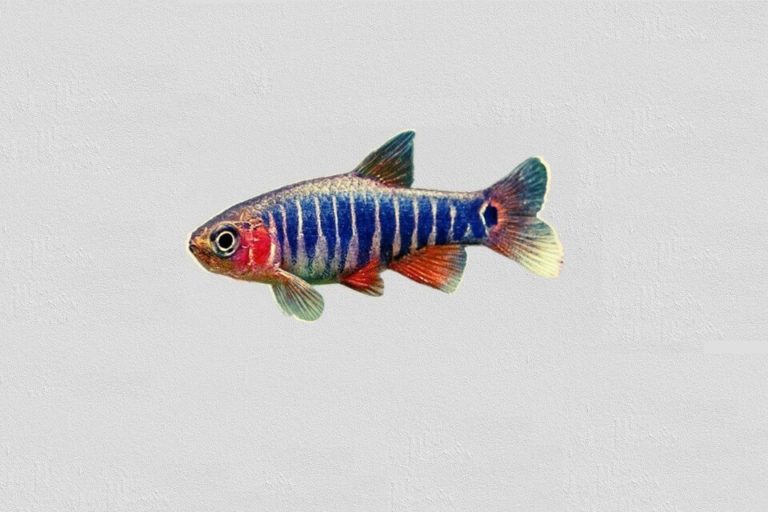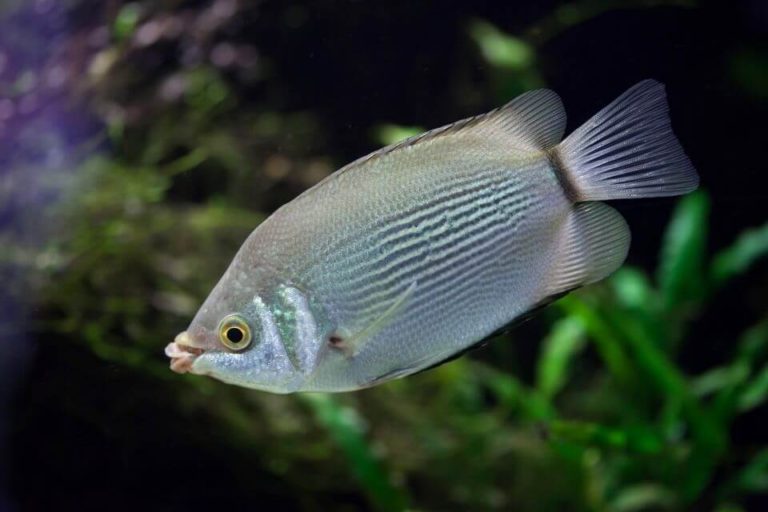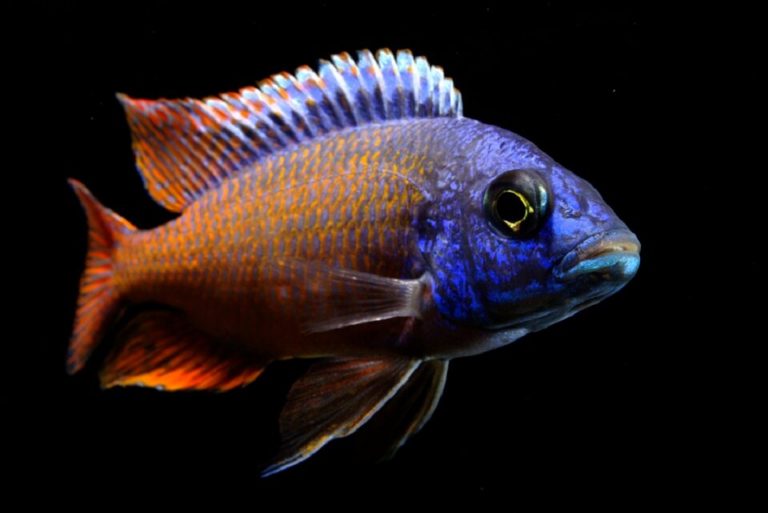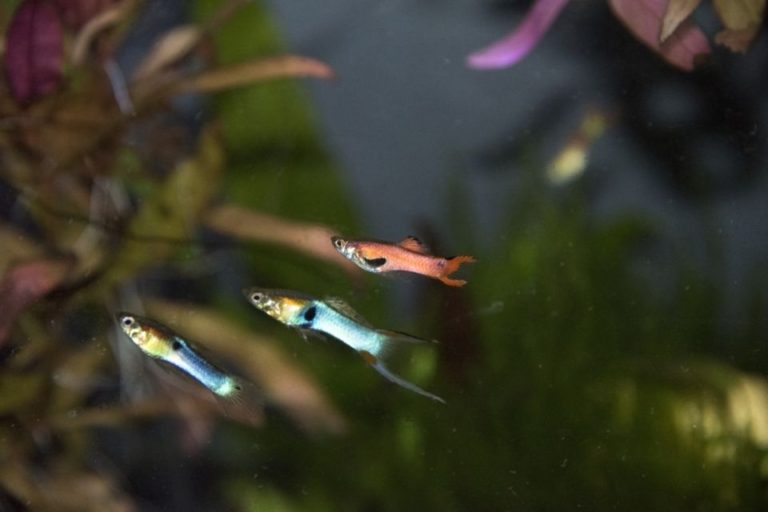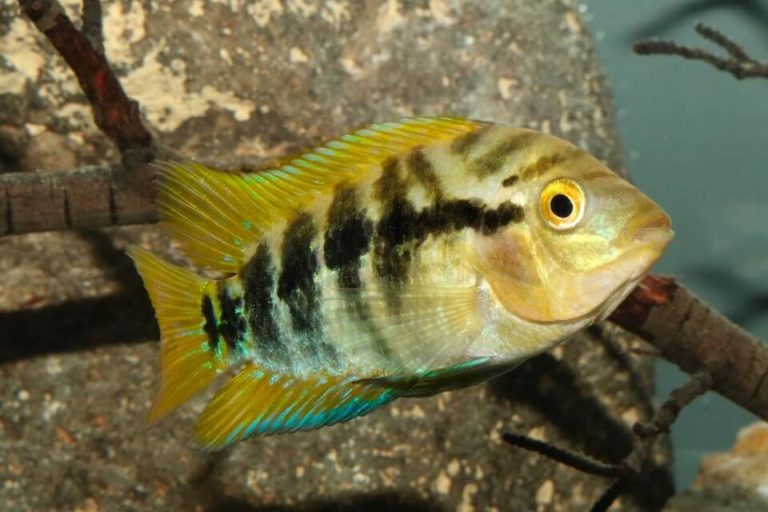Pearl Gourami Care Guide – Size, Lifespan, Tank Mates, Tank Setup & Diet
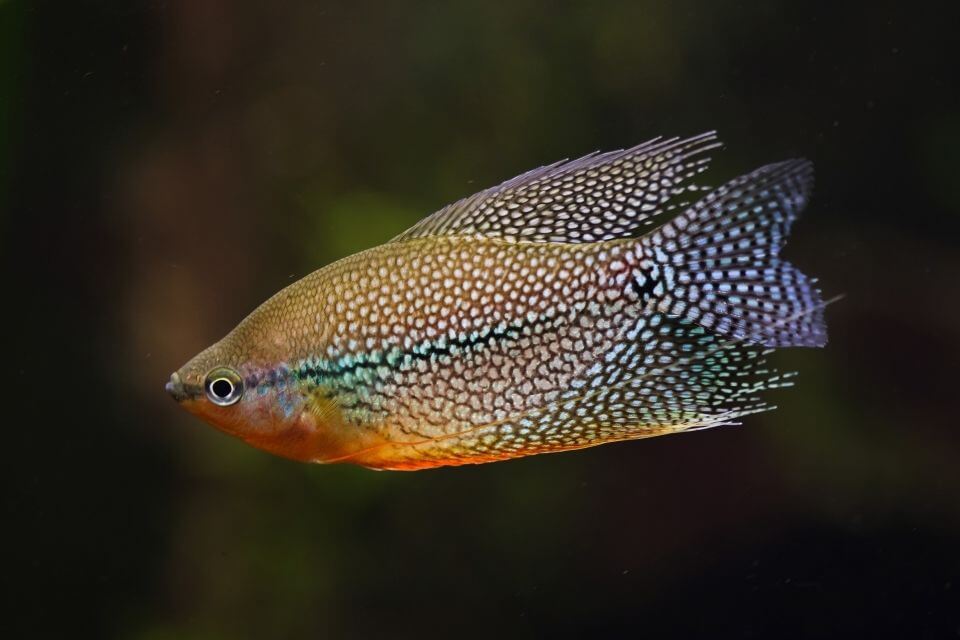
Pearl Gourami fish is a beautiful and unique freshwater fish species from the Gourami family. They are fun, and they add an aesthetic appeal to your fish tank.
The fish has a wide array of white spots on their entire body with large fish that makes it stunning to look at.
Although they are easy to care for, you’ll still need a bit of experience as it’s possible to make newbie mistakes, especially if you are breeding a large group.
This guide discusses how to care for Pearl Gourami fish from choosing ideal tank conditions, tank mates, and diet and feeding.
Species Overview
Pearl Gourami is scientifically known as Trichopodus Leerii, and it is from the Osphronemidae family.
This stunning fish species is characterized by its mosaic and mother-of-pearl-like sheen that captures your attention at first sighting. Pearl Gourami fish originates from East Asia, particularly in Thailand, Malaysia, and Indonesia.
It thrives in slow-moving freshwater bodies, so you will mostly find it in lowland swamps on the seashores in acidic water or more stagnant water such as low rivers and lakes.
This freshwater labyrinth fish has also been sighted in Singapore and Colombia. Pearl Gourami is also referred to as Lace Gourami, Mosaic Gourami, or Diamond Gourami, and this is because of the different patterns on their bodies.
In their native habitat, Pearl Gourami fish spend most of their time in the top half of the water body. It is on the list of endangered species due to water projects and changes in the ecosystem, which has disrupted their natural habitat.
Pearl Gourami Size
The full grown Pearl Gourami size ranges between 4 and 5 inches. But note that this length does not include the bonus length attributed to their ventral fins.
Pearl Gourami size can be affected by several factors, including their genetics, gender, age, and care. So ensure that you are providing them with optimum care for maximum length and life.
Pearl Gourami Lifespan
In their native habitats, Pearl Gourami lifespan is up to 5 years. However, when raised in an aquarium under optimum tank conditions, Pearl Gourami lifespan will increase by up to 7 years or more.
Behavior & Temperament
Pearl Gourami is a mellow and peaceful fish, making them a suitable tank mate for other temperate fishes. However, the males are a tad aggressive, especially during mating; thus, it’s best to house several females with one male.
Their gentle natures make them suitable tankmates to other critters. When introduced into a new aquarium, Pearl Gourami fish take time to adjust because of their timid nature. Thus, you will find them hiding in the aquarium plants.
And since they have large and bright fins, make sure that you do not house them together with fin nippers or aggressive tank mates.
Pearl Gourami spend their time at the top part of the tank, and they breathe fresh air because they have a labyrinth organ. However, juveniles breathe through the gills till they grow up and develop the labyrinth organ.
So, when adding floating aquarium plants, keep this in mind not to block their path to oxygen.
Ensure to provide them with plenty of space to swim around because being active reduces their stress levels, especially in males, since they tend to become more aggressive as they age.
Appearance and Colors
Pearl Gourami fish is a unique and beautiful freshwater fish species, which is why many aquarists keep this Gourami species as aquarium pets. The name “Pearl Gourami” because of the bright pearl-like sheens on their body.
This fish species has a brownish to silver body covered in pearl patterns with a black line that extends from the head towards the caudal fin. As the line goes down, it becomes thinner and thinner.
You can distinguish Pearl Gourami fish from other Gouramis with their spots, fins, size, and colors. They have thin, large, and wide fins that give them an elegant and delicate appeal.
The only place you will not see the white spots is below their mouth and slightly down to their belly.

Pearl Gourami has a thin and flat body that is relatively long, giving it an elegant look as it sways from side to side. They are also set apart by their long and thin ventral fins that dangle when they swim.
The fins extend past the caudal fins and give the fish a stunning look. You can easily distinguish between male and female Pearl Gourami because males have red breasts, which get brighter as they mature and when they’re in their mating season.
You will also notice that their dorsal fins are longer and more pointed than the females. The males are also larger, stronger, and slimmer than the females.
Pearl Gourami Care and Tank Setup
Although Pearl Gourami fish is not hard to care for, you’ll still need some experience to avoid making rookie mistakes. This fish species is hardy and does not need a lot of attention.
So, just educate yourself on the must-know things, such as water parameters, diet, and tankmates, to enable them to live a long and healthy life. If you want your fish to be happy and healthy, ensure that the tank emulates their native habitat.
So, take your time designing and setting up the aquarium and include all the decorations because when they are busy, they won’t suffer from stress and any other illnesses. Above all, make sure to change the water regularly.
– Pearl Gourami Tank Size
The minimum tank size for rearing Pearl Gourami should be between 20 gallons to 30 gallons, and you can go as high as 60 gallons depending on the number of fish you want to keep.
Having enough space is crucial for the well-being of your Peral Gourami as it will give them plenty of areas to explore and play with the plants and decorations on the pond surface.
If you are looking at keeping more than one Pearl Gourami fish, make sure to add the tank by 10 gallons per fish.
– Pearl Gourami Tank Setup
Pearl Gourami’s natural habitat consists of swampy slow-moving acidic water, with lots of plants and vegetation, and you must set up your tank based on this.
Substrate: Although Pearl Gourami spends most of its time at the aquarium’s top part, it is good to use the sand or gravel substrate because sometimes it likes to dig into the sand and create burrows/ caves.
To replicate their natural environment, make sure to use sand or fine-grained gravel. Ensure that is sand is dark-colored to give a swampy feel.
Decorations: Decorations keep your fish busy, so make sure to add artificial caves and rocks since plenty of them are in their native habitat. If you have plenty of space, you can add logs and driftwood.
However, don’t go overboard with decoration and make the tank cramped up as it will increase the chances of the fish getting stressed up.
Filters: A filter is essential to clean the water and prevent excess water flow since Pearl Gourami fish like slow-moving water.
Lighting: Pearl Gourami has a timid personality and is sensitive to temperature changes and water contamination. Therefore, ensure that your tank is spacious to avoid collision with tank mates and has dim lighting.
Together with the shadow provided by the plants, it will give a swampy feel.
– Water Conditions And Parameters
Ensure that the water flow is slow by installing an aquarium water filter. Always maintain stable water parameters because Pearl Gourami is sensitive to temperature changes and water contamination.
Some of the factors to pay extra attention to include:
- Tank Temperature: between 75 and 82 degrees Fahrenheit (24 to 28 °C)
- Water Acidity: 6 and 8 pH
- The hardness of water: 5 to 25 dKH
If your water hardness is less, you can adjust it by adding calcium bicarbonate to increase the hardness. Or you can use electronic water softeners if the water is too hard.
– Suitable Plants
Since Pearl Gourami has a timid personality, you’d better add more plants to make them feel comfortable when hiding. Use plants with a robust root system and place them along the back of the tank or the walls.
You should also add a few floating plants to provide the fish with additional shadow. Some of the best plants for the Pearl Gourami tank include Java Moss, Hornwort, Water Lettuce, and Watersprite.
Possible Diseases And Prevention
Like most fish, Pearl Gourami is affected by fin rot, a bacterial infection that causes decay and discoloration of the fins. This bacteria grows in poor-quality water and develops rapidly in fish that have damaged fins.
And since Pearl Gourami is a victim of fin nippers, ensure that you do not present a chance for fin nipping in your aquarium. So make sure to find suitable tankmates.
Your Pearl Gourami fish is also likely to be affected by other diseases, including Ich, fish fungus, ammonia poisoning, dropsy, and swim bladder disease.
The most notable symptom of these diseases is reduced fish activity, fin discoloration, and lack of appetite. So keep a close eye on your fish if you notice any of the above symptoms for early intervention.
However, prevention is better, and since Pearl Gourami is sensitive to water to poor water conditions, always ensure that the aquarium’s water is changed once every week and wipe down excess algae.
When the water is clean and the parameters are correct, the bacteria will have no growing ground; thus, reducing the likelihood of your fish getting sick.

Diet And Feeding
Pearl Gourami are not picky eaters, meaning that they can feed on both meat and plants, giving you a wide range of choices when it comes to their diet.
However, you have to provide them with a balanced diet to ensure a healthy and long life.
In their native habitat, Lace Gourami feasts on all types of insects, protein-rich eggs, and algae. And when they are playing around, you will find them snacking on the plants.
The good thing is you won’t have a problem feeding them as you can find fish foods, such as pellets, flakes, live and frozen meat, from the pet store.
Finding a quality and live food supplier is challenging; therefore, most aquarists breed their own. You also can do this in a separate tank and rear your own brine shrimps and blood worms in your home compost.
To balance the diet, ensure that you add a few vegetables, such as zucchini and lettuce. Wash them first not to introduce foreign objects in the aquarium and cut them up into tiny pieces.
Feed your Pearl Gourami fish 2 or 3 times a day, and make sure to only feed in small amounts so that they can finish in a few minutes.
Small amounts ensure that you are not overfeeding your fish and help you avoid making the water dirty quickly due to food decay.
How Can You Tell If A Pearl Gourami Is Male Or Female?
Distinguishing between male and female Lace Gourami is easy because male Gourami is thin and angular while females are rounder.
Males have red spots and tend to be more colorful than females. Males are also easy to tell apart because they have an orange-red tone around their throats, chests, and abdominal fins.
During spawning, the red color in males becomes brighter to attract the females. The coloring also gets more brilliant as the male fish gets older. The females are silver-colored on their chest and throat.
And while the females have shorter, smaller, and rounded dorsal fins, the males have long and pointed dorsal fins.
Pearl Gourami Breeding
Compared to other Gourami species, breeding Pearl Gourami fish is difficult. Their breeding process is much different from other Gourami species because they build a bubble nest before laying eggs.
The male is tasked with blowing a lot of bubbles when they are looking to mate. The bubbles float to the top of the water and most often lodge themselves onto the plant to prevent them from flowing away with water.
They coat the bubbles with a lot of salivae to make them more durable. Make sure to use a separate tank for breeding, preferably 30 gallons or above. This is because Pearl Gourami is very fertile.
And ensure that the water level should not go above 10 to 12 inches from the tank bottom. The water parameters in the breeding tank should be maintained at optimum levels to ensure healthy spawns.
The water should be soft with a pH of 7.0, and the temperature should range between 80 to 89 degrees Fahrenheit (27 to 32 degrees Celsius). Before breeding, it is recommended that you separate the male and the female.
Please keep them in a separate tank and feed them well in preparation for spawning. Then introduce the male to the breeding tank first and then add the female later.
To speed up the spawning process, you can change 1/5 of the water and increase the temperature by 2 or 3 degrees Celsius.
Once the nest is set, the male then coaxes the female and leads it beneath the nest so that when it spawns, the eggs will float up to the nest. The female spawns eggs for about 2 hours as it lays them in portions.
A female Pearl Gourami can lay up to 300 eggs at a time. Once spawning is over, remove the female from the breeding tank and leave the male to look after the eggs.
The eggs phase lasts for about two days, after which they hatch, and in five days, the juvenile Pearl Gourami fish can swim.
Although adult lace Gourami has a labyrinth organ that makes it easy to breathe, the juveniles have gills, ensuring that the tank has a good oxygen supply.
At this stage, remove the male from the breeding tank to minimize the chances of mistaking the fries for food. Reduce the water level to about 6 to 10 cm and maintain at this level for one month till your juveniles develop the labyrinth organ.
During this time, you can feed them with infusorian and zooplankton. These Gourami species can breed 3 to 4 times each season, and their fertility lasts until they are around 5 years old.
Pearl Gourami Tank Mates
Pearl Gourami has a timid personality, and they are considered peaceful, making them a great addition to a community tank. You will have a lot to choose from when looking for Pearl Gourami tank mates.
The best Pearl Gourami tank mates include:
- Celestial Pearl Danios
- Neon Tetras
- Dwarf Cichlids
- Guppies
- Cherry Barbs
- Bristlenose Pleco
- Cory Catfish
- Hatchetfish
- Swordtail Fish
You can also include bigger fish that are not aggressive. Catfish are a great addition, and since they spend most of their time at the bottom part of the aquarium, their chances of coming across Pearl Gourami are minimal.
Avoid overactive tankmates as they will intimidate Pearl Gourami, stressing them out and causing them to go into hiding. The stress may also lead to health problems.
It would be best to avoid fin nippers because Pearl Gourami has large, delicate, and bright fins that easily attract the nippers. You can include other types of tankmates, such as shrimp and nerite snails.
The upside of adding these is they feed on the algae, thus helping keep the tank clean.
Origin and Distribution
Pearl Gourami was initially found in Malaysia, Thailand, and Indonesia. Pearl Gourami thrive in slow-moving lowland swamps near seas where the water acidity is high in their natural environment.
These waterbodies have thick vegetation where they can hide and breed. As mentioned above, due to climatic changes and disruption of the natural ecosystem, Pearl Gourami is listed as an endangered species.
But to preserve these stunning fish, they are now bred in private and made available to aquarists across the globe. So if you want to keep Pearl Gourami, you can buy it in your local pet store or online, and it will be delivered to your doorstep.
FAQs
How Many Pearl Gouramis Should Be Kept Together?
Pearl Gourami fish prefer shoaling on their own in groups of six (6) or more. They are active, and when you keep them as a group, you have better chances of observing their behavior.
Furthermore, a shole of Pearl Gourami fish will be pleasing to the eye. However, make sure that there are fewer male Pearl Gourami in a group because they tend to be aggressive.
Ensure that you maintain male to female ratio in a reasonable number. It is better to keep 2 or 3 females per one male Gourami. Besides, they are happier in a shoal.
Are Pearl Gouramis Aggressive?
Pearl Gourami is a peaceful and mellow species. However, the males tend to be aggressive toward their fellow species, especially in the breeding season.
Are Pearl Gouramis Good Community Fish?
Yes, absolutely it is. Pearl gourami are a peaceful species, meaning that they will do well in a community tank.
However, ensure that there are no aggressive tank mates because Pearl Gourami is easily intimidated, which may increase their stress levels resulting in health problems.
Also, ensure there are no fin nippers in the same tank. It’s best if the tank has peaceful and same-size tank mates.
Why Is My Pearl Gourami Turning Orange?
This happens during the breeding season. When the female abdomen is full of eggs, the male’s breast area spreads underneath along the anal fin and turns Orange in preparation for breeding.
Can Pearl Gouramis Live With Bettas?
Not really. Although they are from the same fish family, they are not compatible tank mates. This is because they share many characteristics and almost resemble each other which may bring out their aggressive tendencies.
Where We Find Pearl Gourami For Sale?
Because of the demand, the Pearl Gourami is now bred privately. Therefore you can buy them from your local pet store or online from trusted breeders.
How Much Does Pearl Gourami Cost?
The average price for a single Pearl Gourami with a size of 4 to 5 cm goes for around $4 in the USA Market. It is a pretty average price for a fish, but if you are in a different region then you might see different price ranges.
Final Thoughts
Pearl Gourami will be your best option if you are looking for a beautiful and peaceful fish for your aquarium. Their stunning colors will improve your home aesthetic and give you something to watch in your free time.
It’s especially better if you keep a group of 4 to 5 fish. Mimic their native habitat when setting up the tank and ensure that the water changes weekly for a longer and healthier life.
Please provide them with a lot of hiding places through decorations and plants. And when choosing tankmates, ensure they are peaceful and no fin nippers.


